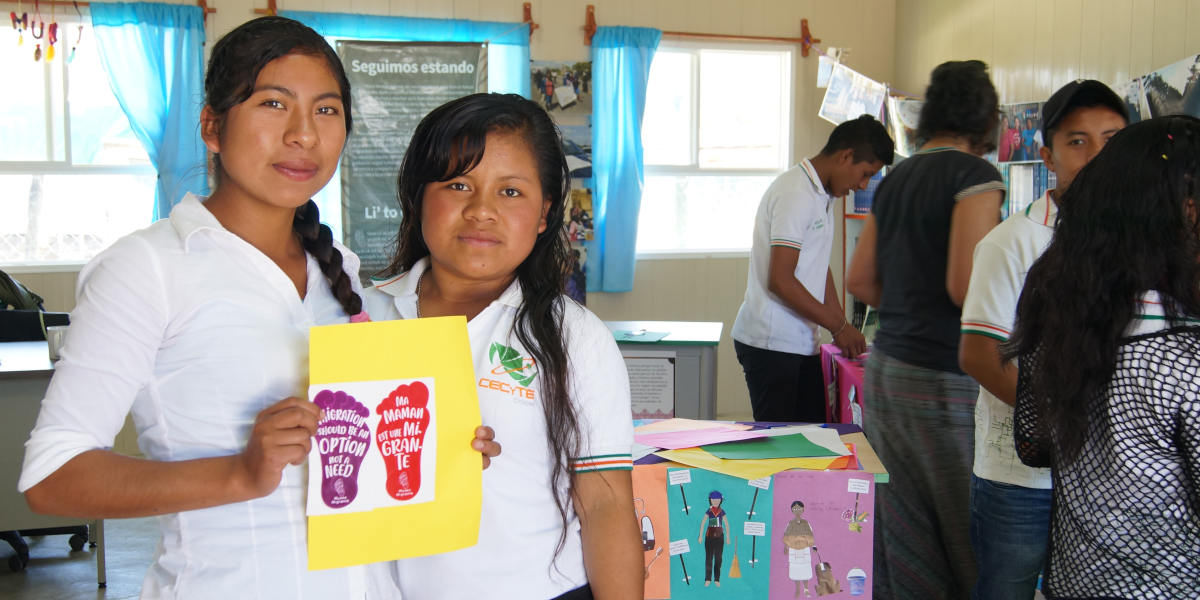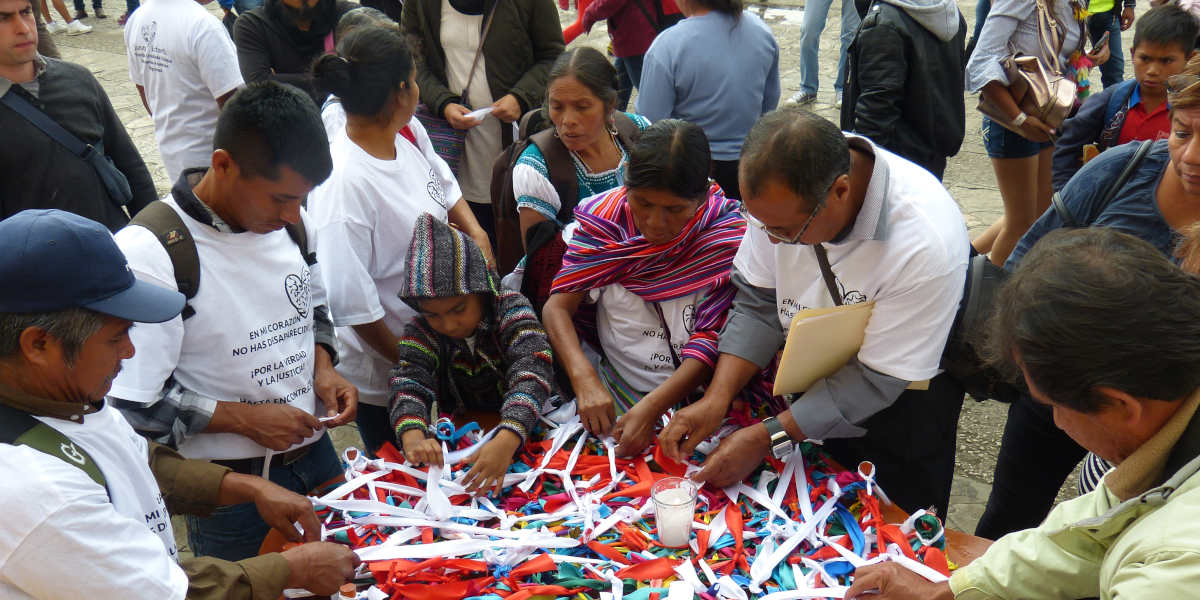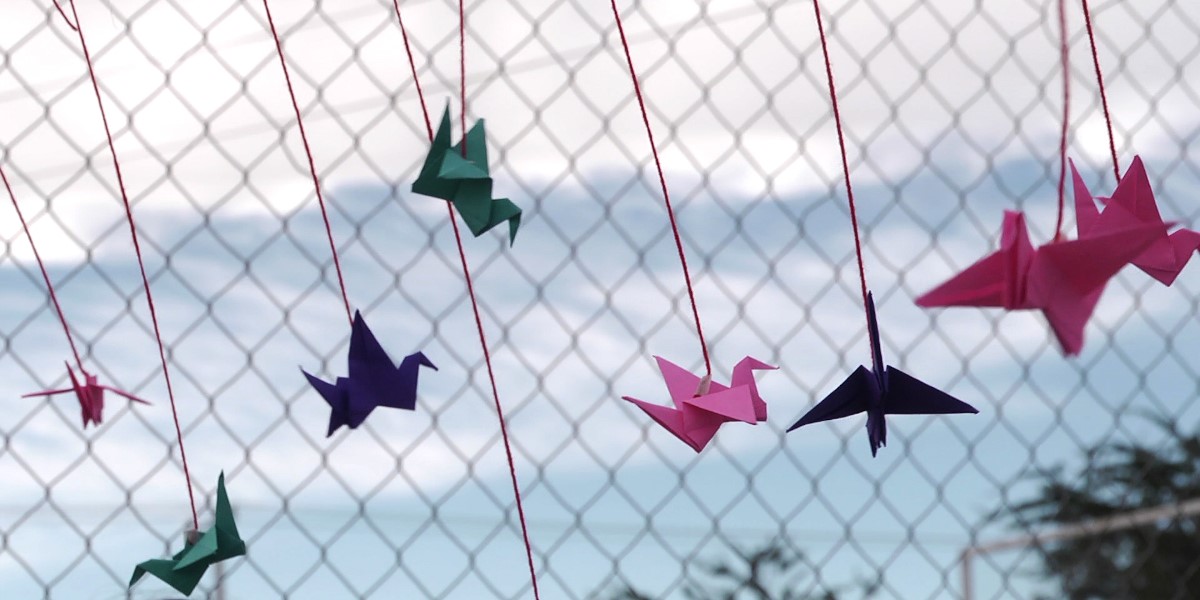The Migration Museum (Museo Migrante, or MuMi) is a travelling ‘pop-up’ exhibition constructed by, with and for indigenous and campesino communities in southern Mexico. A collaborative arts project run through the Chiapas-based NGO Voces Mesoamericanas, where I work, MuMi aims to challenge dominant ideas about the Mexican nation state and the people who live and migrate within and across its physical and imagined borders.
At MuMi, participants encounter photographs and texts written in indigenous languages that capture the physical and symbolic spaces of migration around four main themes: origin, transit, destination and return. Creative activities designed to elicit reflection and response are placed throughout.
Paper dolls invite people to share their stories and dreams, including specifically as migrant and/or indigenous women. They can write or draw their visions of dignified migration on paper to fold into flying birds that are hung around MuMi or carried away by their makers. They can add messages, poems, postcards and narratives to the museum frame, which is sometimes a fence, often a line of rope, occasionally a wall.
We distribute printed information and colourful stickers asserting migrants’ and labourers’ rights throughout the space. This integrates information about fundamental, legally-protected human rights within a forum that asserts the worth, humanity and dignity of peoples excluded by the state. It also celebrates imagination and play as productive, educative tools with radical potential.
MuMi honours migration in its own form: it is dynamic, itinerant, fluid, adaptable. It travels in a suitcase and comes to life at the hands of the communities that welcome it. Its presence responds to and changes spaces. It can draw attention to the importance of place to the community – for example, dignifying day labourers through its presence in the fields that they work. Through juxtaposition, it can make visible notable absences or exclusions, such as by interrupting or intruding into town squares in tourism ‘hot spots’, challenging passers-by to rethink popular imaginaries of indigenous and campesino cultures.

Secondary school students explore a MuMi exhibition set up in a classroom in Southern Chiapas
CREDIT: MUMI
New displays have emerged over time, including ‘Women in Migration’, ‘Migrant Children and Youth’ and ‘Missing Migrants’. The contents and contours of MuMi are always changing. The community decides how the sections are arranged, changing the nuances and emphases of stories told.
In each case, MuMi expresses a political commitment to celebrate lives and opinions that are usually not counted, and to name rights that people have been denied. By creating spaces for communities to share, hear and explore the stories of people who migrate, people who do not migrate and people affected by the migrations of others, MuMi always aims to make visible the knotted roots and complex consequences of domestic and international migration. At heart, it is a popular pedagogical project that positions all people as political subjects with the capacity for action and transformation.
Routes to migration
MuMi has been shaped by a confluence of geographical, historical, cultural and political dynamics. It is based in Chiapas, the southernmost state in Mexico, bordering Guatemala. For decades, the territory has been a site of passage and destination for thousands of migrants trying to reach the United States, as well as a place of origin and return for thousands of chiapanecos. Migration is a significant factor of life here, one of many complexities encountered in a region shaped by painful histories of violence and rich traditions of resistance.
On 1 January 1994, the armed uprising of the Zapatista Army of National Liberation (EZLN) began in Chiapas. Their aim was to restate and reclaim their rights as the North American Free Trade Agreement came into force. This neo colonial accord would have a devastating impact on agrarian and indigenous communities across and beyond Mexico.
The EZLN action was a declaration of war on the Mexican state: a demand for justice and dignity made by and for indigenous communities that it had excluded, dispossessed, abused and subjected to assimilationist agendas. The subsequent EZLN campaign and repressive state responses to it – both of which continue today – provoked significant social, political and economic changes across the region.
Against this backdrop, other crises of the 1990s-2000s increased experiences of displacement and pressure to migrate. First, due to a combination of contamination from industrial pesticides and periods of extreme weather, the land became insufficiently fertile to provide for families. Meanwhile, coffee and other commercial crops started losing market value – another consequence of ‘free trade’ pacts.
Migration is a significant factor of life here, one of many complexities encountered in a region shaped by painful histories of violence and rich traditions of resistance
The increasing precarity of rural life had far-reaching impacts on communities, damaging health, nutrition, jobs, education and the environment. Once again, indigenous and peasant communities were being prevented by the state from forging dignified, autonomous lives within their own territories. We regard the migrations caused by these dynamics as ‘forced migrations’.
Second, as options narrowed for people to remain in their communities, new demands for cheap labour began to appear in national and international industries. Subsequently, and continuing over the past decade, people from southern communities began to find work elsewhere, primarily in masonry and construction (in coastal resorts and urban areas where demand is driven by tourism and business sectors), in industrial agricultural production (concentrated in the northwest of the country) and in domestic and care work (both within and beyond Mexico’s borders). These are, not coincidentally, jobs in poorly regulated, low-paid, insecure sectors that are also devalued socially as low-status, ‘unskilled’ labour.
Third, the expansion of the drug trade across Mexico and the catastrophic US-Mexico ‘war on drugs’ have exacerbated insecurity and increased the militarised surveillance of already-marginalised people. Corruption is endemic throughout state agencies, and there is little oversight over military excursions made in the name of countering narcotráfico.
At a conservative estimate, since 2006, around 290,000 people have been killed and a further 70,000 disappeared during and because of the ‘war on drugs’. As of September 2020, nearly 39,000 unidentified bodies had passed through mortuaries in Mexico in just 14 years. It is likely that many of them were people who had migrated.
Due to the particular ways in which colonialism, neoliberal capitalism, racism and patriarchy have been rooted and expressed in Mexico, a complex and layered network of intersecting oppressions – along class, ethnic, linguistic, cultural, gender and generational lines – has embedded and exacerbated these three interconnected crises.
Consequently, migratory flows from, to and through Chiapas – which are crucial to the Mexican economy and to the sustenance of the global capitalist system – are marked by widespread labour exploitation, human trafficking, violence, disappearances and death.
Demanding rights and dignity
It is within this context that MuMi emerged and exists as a project that seeks to defend and promote the rights of all migrants, and to establish the possibilities of buen vivir and relatedly buen migrar. Buen vivir is a concept popularised by indigenous and social leaders and used widely across Latin America, with different and changing contextual emphases and nuances. It is not akin to the western concepts of ‘well-being’ or ‘the good life’.
It is instead a rejection of colonialism, patriarchy and capitalism – an affective, spiritual, intellectual and political stance that regards nature and society as indivisible, values plurality and upholds principles of reciprocity, communalism, redistribution and equity. Buen migrar echoes this ethos in the context of migration.
These aspirations persist, despite the painful realities we have described here, because indigenous, campesino and migrant populations in Chiapas continue to engage in multiple and varied forms of resilience, adaptation and survival that are driven by love for their families and communities and the desire for better lives forged on their own terms.
Indigenous community members in Chiapas create a heart from coloured ribbons in memory of friends and family who have gone missing after migrating
CREDIT: MUMI

This is why, even though MuMi aims to make visible the structural and social forces that threaten communities’ well-being, it above all strives to highlight the dreams, hopes and levity that also endure here. These are to be found amid dignified struggle and networks of solidarity between young people eager to reshape their presents and futures and las mujeres que se acuerpan – a concept roughly translated as ‘women who put their bodies on the line for each other’.
MuMi emerged in 2012, growing out of Voces’ work with young people in Chiapas. Their artistic work presented nuanced and thoughtful accounts of migration, as many had experienced migration themselves, or within their families. We decided together to present it on street stages and at public events held in San Cristóbal, where ‘revolutionary’ and ecological tourism has led to gentrification, exacerbates inequalities and often contributes to the folklorisation of indigenous peoples.
Our decision to create an exhibition – and later, a travelling ‘museum’ – from these works was based on our recognition that doing so was not only an act of sharing stories, but also of publicly valuing and dignifying migrant and indigenous experiences.
Priorities
MuMi’s first priority remains ensuring that people from the communities are reflected in and recognise themselves in the stories it holds. This strengthens our efforts to exercise and defend our human rights and creates foundations for political organisation endowed with identity and cultural significance.
Its second priority is to encourage deeper understanding of migration, particularly in those who hold negative views of migrants, by engendering reflection, empathy and solidarity – dismantling feelings of contempt, hatred and racism that are fuelled by xenophobic and colonial constructions of the ‘other’ and capitalist frameworks of ‘deservingness’.
This is a very difficult task. We are not only trying to ‘raise awareness’ but also to raise consciousness. That is to say, we intend not only to change what people know and think about migration but also to encourage them to actions that will cause a radical, tangible socio-cultural shift towards a more just and equitable future for all.
MuMi honours migration in its own form: it is dynamic, itinerant, fluid, adaptable. It travels in a suitcase and comes to life at the hands of the communities that welcome it
Our pedagogical approach is informed by our insights that laughter, fun, and cooperative play are useful tools for dismantling fears of making mistakes and for forging friendships, alliances and collaborations. That, in turn, helps participants to develop their own voices and to listen as others express theirs.
In the midst of violence and precarity, it can feel risky to invest in and express hopes and aspirations. Yet it is imperative to do so if we are to challenge dominant realities and create robust and sustainable alternatives. Art is an important vehicle to that end, as a realm of imagination in which possibilities can be explored, (re)constructed and effectively given life.
Against extractive ‘knowledge’
MuMi is, like all museums, a political educational project. Unlike most museums – including those grand, urban institutions that narrate the ‘official’ history of Mexico – it questions rather than venerates popular constructions of the nation state. It posits that the knowledge about indigenous, campesino, migrant and other communities marginalised by the state must come from within those same communities – it cannot be dictated from above, or from without.
In providing a forum for reflection, expression and dialogue, MuMi facilitates processes through which the exclusionary policies and narratives of the state may be actively contested and alternative, dignifying knowledges may be asserted.
MuMi does not amass an archive, but neither is its will to forget. It assertively claims the title ‘museum’ because it is a space in which people of various nations who live within the Mexican state learn about their histories, cultures, cosmologies, ideologies and politics by articulating and debating them.
Its central protagonists are not named, uniformed heroes, or unnamed archetypes calcified in glass cases, frozen in time, but an ever-changing cast of all those who contribute to it. Its objects are not fetishised but played with, made and remade, just as our lives are always transforming, being reinvented and rebuilt. MuMi is, like all museums, a political, pedagogical and artistic tool.
Of course, these aspirations are not always met. It is imperative to adopt a critical and reflective stance as MuMi continues to evolve. As an initiative of Voces, MuMi is faced with the same funding and resource limitations as all NGOs working under neoliberal capitalism, in which the pursuit of a politics that questions the foundational narratives and structures of the nation state is rarely regarded by financiers as a funding priority. The challenge is always to work within (and to overcome) those constraints.
There must be scope, too, for debate: feelings of connection and empowerment are productive but there must also be openness for disagreement and rejection of ideas. There will not be an endpoint at which the representational choices of MuMi are deemed ‘complete’.
That is the nature of an ongoing conversation about new realities that we may together create. The knowledge produced and shared by and for its participants within MuMi is not intended to be shared here. We hope, however, that the story and ethos of MuMi are informative for people everywhere seeking to live and migrate with dignity.










